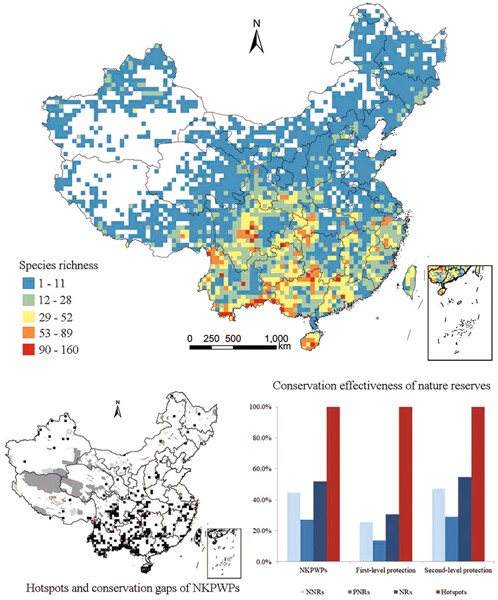Journal of Systematics and Evolution >
Geographic distribution, conservation effectiveness, and gaps for national key protected wild plants in China
- 1 State Key Laboratory of Systematic and Evolutionary Botany, Institute of Botany, Chinese Academy of Sciences, Beijing 100093, China;
2 University of Chinese Academy of Sciences, Beijing 100049, China;
3 Guangxi Institute of Traditional Medical and Pharmaceutical Sciences, Nanning 530022, China;
4 College of Forestry, Central South University of Forestry and Technology, Changsha 410004, China;
5 Guangxi Key Laboratory of Plant Conservation and Restoration Ecology in Karst Terrain, Guangxi Institute of Botany, Guangxi Zhuang Autonomous Region and the Chinese Academy of Sciences, Guilin 541006, Guangxi, China;
6 College of Forestry, Guizhou University, Guiyang 550025, China;
7 School of Life Science, Guizhou Normal University, Guiyang 550025, China;
8 Department of Ethnobotany, Institute of Botany, Ilia State University, Tbilisi 0105, Georgia;
9 Department of Botany, State Museum of Natural History, Karlsruhe 76133, Germany;
10 College of Tourism and Urban-Rural Planning, Chengdu University of Technology, Chengdu 610059, China
†These authors contributed equally to this study.
*Authors for correspondence. Sheng-Xiang Yu. E-mail: yushengxiang@ibcas.ac.cn; Juan Wang. E-mail: Id.wangjuan@foxmail.com; Rainer W. Bussmann. E-mail: rainer.bussmann@iliauni.edu.ge
Received date: 2022-04-08
Accepted date: 2022-11-30
Online published: 2022-12-07
Abstract

Cite this article
Fei Qin, Xiao-Xia Zhang, Yun-Feng Huang, Lei Wu, Wei-Bin Xu, Tian-Tian Xue, Wen-Di Zhang, Qin Liu, Jiang-Hong Yu, Jie-Jing Gao, Rainer W. Bussmann, Juan Wang, and Sheng-Xiang Yu . Geographic distribution, conservation effectiveness, and gaps for national key protected wild plants in China[J]. Journal of Systematics and Evolution, 2023 , 61(6) : 967 -978 . DOI: 10.1111/jse.12941